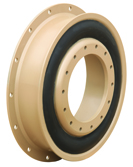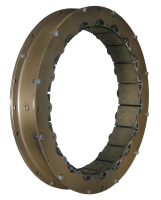Marine

A propeller is the most common propulsor on ships, imparting momentum to a fluid which causes a force to act on the ship.
The blades are attached to a boss (hub), which should be as small as the needs of strength allow - with fixed pitch propellers the blades and boss are usually a single casting.
An alternative design is the controllable pitch propeller (CPP), where the blades are rotated normal to the drive shaft by additional machinery - usually hydraulics - at the hub and control linkages running down the shaft. This allows the drive machinery to operate at a constant speed while the propeller loading is changed to match operating conditions. It also eliminates the need for a reversing gear and allows for more rapid change to thrust, as the revolutions are constant. This type of propeller is most common on ships such as tugs[citation needed] where there can be enormous differences in propeller loading when towing compared to running free, a change which could cause conventional propellers to lock up as insufficient torque is generated.

An Azimuth thruster is a configuration of ship propellers placed in pods that can be rotated in any horizontal direction, making a rudder unnecessary. These give ships better maneuverability than a fixed propeller and rudder system. A Z-drive thruster has an horizontal input shaft, vertical shaft in the azimuthing column and a horizontal output shaft with two right-angle gears.

Pneu‐Grip clutches can be found on ships and vessels in marine drives, bow thrusters, main propulsion and propeller shaft brakes as well as dredgers.